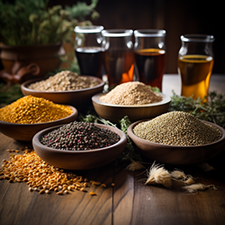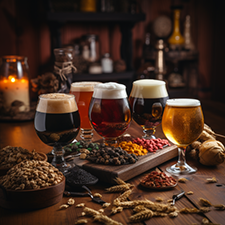Grain Gurus: The Art of Mixing Grains for Beer Making
Posted by Matteo Lahm on 14th Feb 2024
You're reading this because you're not just a beer drinker but a beer making thinker. You're curious about how you can mix the various grains that turn that humble glass of brew from an ordinary beer into the mysterious, deep and irresistibly sexy Greta Garbo of beverages. So let’s take a stroll through the grain fields of Barley, Wheat, Oats, Rice, and Corn, and learn how you can combine them to shape the color, opacity, flavor and mouthfeel of your favorite brews.
First up, the king of all beer grains: Barley. Barley is like the Marlon Brando of beer grains. He is considered the greatest Hollywood actor ever and the standard bearer of a great performance. Barley is versatile, reliable, and the reason to not try reinventing the wheel. It's the backbone of most beers. The malted version of barley gives beer its color and a range of flavors from sweet caramel to toasted bread. Guinness Stout, anyone? That's barley channeling its its darker and more mysterious inner Brando as Don Corleone.

Next, there’s Wheat. Wheat in beer is like adding a bit of sunshine to your brew. It gives your beer a hazy, golden glow and a frothy head that sticks around longer than your in-laws at Christmas. Wheat beers are light, with a hint of fruitiness, perfect for those hot summer days. Ever had a Hoegaarden or a Blue Moon? That's wheat working its magic.
Now, let's talk about Oats. Oats in beer are like that comfy, oversized sweater you love. They give your beer a smooth, creamy mouthfeel that's just so darn comforting. Oats also add a touch of sweetness and a hint of nuttiness. If you've ever enjoyed a Samuel Smith's Oatmeal Stout, you've experienced the cozy charm of oats.
Rice and Corn are the wild cards in the beer grain game. They're like the eccentric uncles of the grain family. They don't add much in terms of flavor, but they lighten the body of the beer and boost the alcohol content without making the beer too heavy. Budweiser and Coors are famous for using these grains. They're the reason you can enjoy a few cans at the BBQ without feeling like you've eaten a loaf of bread.
Mixing these grains is where the real fun begins. It's like being a mad scientist, but instead of creating monsters, you're creating delicious beer. It's the culinary equivalent of mixing paint on a palette, each grain adding its unique hue to the masterpiece that is your brew.
Let's start with the classic combo: barley and wheat. A 50/50 mix will give you a brew that's robust from the barley, yet refreshing from the wheat. It's like Holmes and Watson for your taste buds, two very different personalities who teamed up to be a legendary partnership. But don't be afraid to play around with the ratios. A 70/30 mix in favor of barley will give you a beer that's more full-bodied, with the wheat adding a subtle hint of fruitiness. On the other hand, a 70/30 mix favoring wheat will result in a lighter, more refreshing beer with a hint of barley's robustness.
Now, let's talk about oats and barley. This duo is like Myles Davis sharing the stage with David Gilmour, mellow yet full of depth and psychedelia. A 60/40 mix of barley to oats will give you a beer that's smooth from the oats, yet full-bodied from the barley. It's the kind of beer that makes you want to sit by the fire and contemplate the meaning of life while you are listening to Dark Side of the Moon. But again, don't be afraid to experiment. A 70/30 mix favoring oats will result in a beer that's creamier and sweeter, while a 70/30 mix favoring barley will give you a beer that's more robust, with a hint of oats' smoothness.
The possibilities are as endless as the varieties of beer. You can even throw rice and corn into the mix if you're feeling adventurous. A 60/30/10 mix of barley, wheat, and rice can result in a beer that's robust, refreshing, and light, perfect for those long summer BBQs.
Remember, though, beer making is an art and a science. The science is using the ratios as starting points. The real magic happens when you start experimenting and finding the perfect balance that suits your palate. So, go forth, mix, brew, and most importantly, enjoy the process. After all, you don’t make beer just to drink. You take pride in your craft and want to enjoy it as much as possible.

Remember, a little too much adventure without a dose of caution can also be a little dangerous. Too much wheat can make your beer too cloudy, and too many oats can make it overly sweet. And while rice and corn can lighten your beer, they can also dilute the flavor if used excessively. So, tread carefully and while you don’t want to necessarily risk making a bad batch, there are many a beer maker who insist that you have not earned your cred until you’ve tried something and failed. That is the nature of the beast, and discovery. There is always the haphazard treasure hunt for that happy accident that changes your beer making life. They are like Picasso inventing cubism. One of the most famous examples of this is the creation of the Belgian Tripel.
Legend has it that the Belgian Tripel was born out of a brewing blunder at the Trappist monastery of Westmalle in the 1930s. The monks were aiming to brew a strong, pale ale, but they ended up adding too much sugar. Instead of dumping the batch, they decided to roll with it and see what happened.
The result was a beer that was stronger than they intended (around 9% ABV), but it was also surprisingly light-bodied and flavorful, with a complex profile of fruity esters and spicy phenols. The beer was a hit, and the Belgian Tripel style was born.
The moral of the story? Sometimes, the best things in life are the ones we don't plan for. So, don't be afraid to make mistakes in your beer making journey. Who knows, you might just stumble upon the next big thing in beer.
In the end, the grains you choose for your beer will shape its character, its flavor, its very soul. So, go forth, experiment, and create. And remember, no matter what any of the rigid perfectionists say, sometimes you must be willing to make a mess to create a work of art. Now, go make some beer magic!

